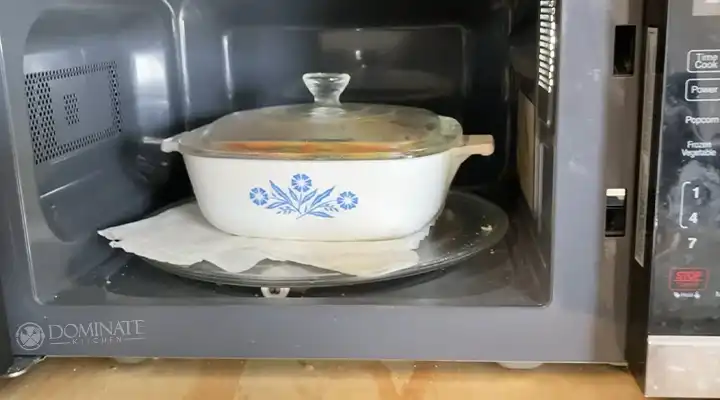Can CorningWare Go from Fridge to Oven? Is it Safe to Go?
Can CorningWare go from the fridge to the oven? The answer is a solid yes, and it’s one of the reasons I’ve come to appreciate this versatile kitchen companion over the years. In this comprehensive guide, I will discuss what CorningWare is, its capacity to sustain oven temperatures, considerations for using its lids, handling old and vintage CorningWare, what to watch out for, some pro tips for seamless cooking, and the advantages and disadvantages of having CorningWare in your kitchen.

What Is CorningWare?
Before we explore its capabilities, it’s important to understand what CorningWare is. CorningWare is a brand of cookware known for its unique composition of borosilicate glass-ceramic material. This special material is designed to handle a wide range of temperatures, making CorningWare suitable for various cooking and baking applications. Its non-porous surface also makes it resistant to staining and easy to clean, adding to its appeal as a kitchen staple.
Can It Sustain Oven Temperatures?
CorningWare’s ability to transition from the fridge to the oven is a testament to its exceptional thermal properties. This glass ceramic material can withstand a wide range of temperatures, making it perfect for both cold storage and oven use. However, it’s important to keep a few considerations in mind.
- Temperature Limits: CorningWare is generally safe for use in ovens up to 500°F (260°C). While this temperature range covers the vast majority of recipes, it’s wise to avoid extremely high-heat cooking methods that exceed this limit.
- Lid Considerations: The lids of CorningWare dishes are typically made of Pyrex glass, which is also heat-resistant. However, they may have different temperature limits. It’s best to check the manufacturer’s instructions for specific guidance on your CorningWare product’s lid.
What About Old and Vintage CorningWare?
If you’ve inherited or collected old and vintage CorningWare, you might be wondering if it’s still safe to use. The good news is that CorningWare has a longstanding reputation for durability, but there are some points to consider:
- Check for Damage: Examine the vintage CorningWare for any visible cracks, chips, or damage. If you find any, it’s best to retire the piece, as it may compromise its ability to withstand temperature changes.
- Know the Era: CorningWare has undergone changes in its manufacturing processes over the years. It’s crucial to identify the era your vintage piece belongs to and understand any specific usage recommendations for that era.
- Retain Its Value: Some vintage CorningWare pieces are highly collectible. If you have valuable collectibles, consider preserving them rather than using them for cooking to maintain their condition and value.
What to Look Out For?
While CorningWare’s ability to transition from cold to hot is a major advantage, you should be cautious to ensure the safe use of this cookware:
- Avoid Sudden Temperature Changes: Never place a cold CorningWare dish directly into a hot oven. Let it come to room temperature first to prevent thermal shock, which can lead to breakage.
- Preheat the Oven: Always preheat your oven to the desired cooking temperature before inserting your CorningWare. This reduces temperature fluctuations and preserves the integrity of the cookware.
- Use Oven Mitts: When taking your CorningWare out of the oven, remember to use oven mitts or potholders to protect your hands from the high heat.
- No Stovetop Use: CorningWare is not suitable for stovetop cooking, as it cannot withstand direct contact with open flames or stovetop heat.
- Follow Manufacturer’s Instructions: Different CorningWare products may come with specific care and usage guidelines. It’s essential to consult these instructions for precise guidance on your specific product.
Pro Tips for Using CorningWare?
To maximize your experience with CorningWare and ensure smooth transitions from fridge to oven, consider the following pro tips:
- Grease or Butter: Grease or butter the interior of your CorningWare dish before use to prevent sticking and facilitate easier cleanup.
- Even Heating: CorningWare provides even heat distribution, making it ideal for slow cooking and baking. This can enhance the overall quality of your dishes.
- Utilize Lids: Many CorningWare dishes come with matching lids or covers. These can help retain moisture and flavor during cooking. Don’t forget to use them for the best results.
- Microwave Safe: Most CorningWare pieces are microwave-safe, allowing for the convenient reheating of leftovers before transferring to the oven.
Can I put CorningWare in the dishwasher?
Yes, most CorningWare pieces are dishwasher-safe. However, always refer to the manufacturer’s instructions for specific care recommendations.
Can I use CorningWare on the stovetop?
No, CorningWare is not suitable for stovetop use, as it cannot withstand direct contact with open flames or stovetop heat.
Can I take CorningWare from the freezer to the oven?
While CorningWare is known for its ability to handle temperature changes, it’s best to let it thaw in the fridge first before transferring it to the oven. Going from the freezer to the oven may create extreme temperature fluctuations.
Is CorningWare microwave-safe?
Many CorningWare pieces are indeed microwave-safe, making them a convenient choice for reheating leftovers. Check the product’s label or packaging for confirmation.
In conclusion
CorningWare’s remarkable ability to transition from the fridge to the oven is a testament to its unique composition and durability. With proper care and attention to temperature changes, it can be an invaluable addition to your kitchen, offering versatility, even cooking, and easy cleanup. Understanding its advantages and limitations will help you make the most of your CorningWare cookware and enjoy many delicious meals.






